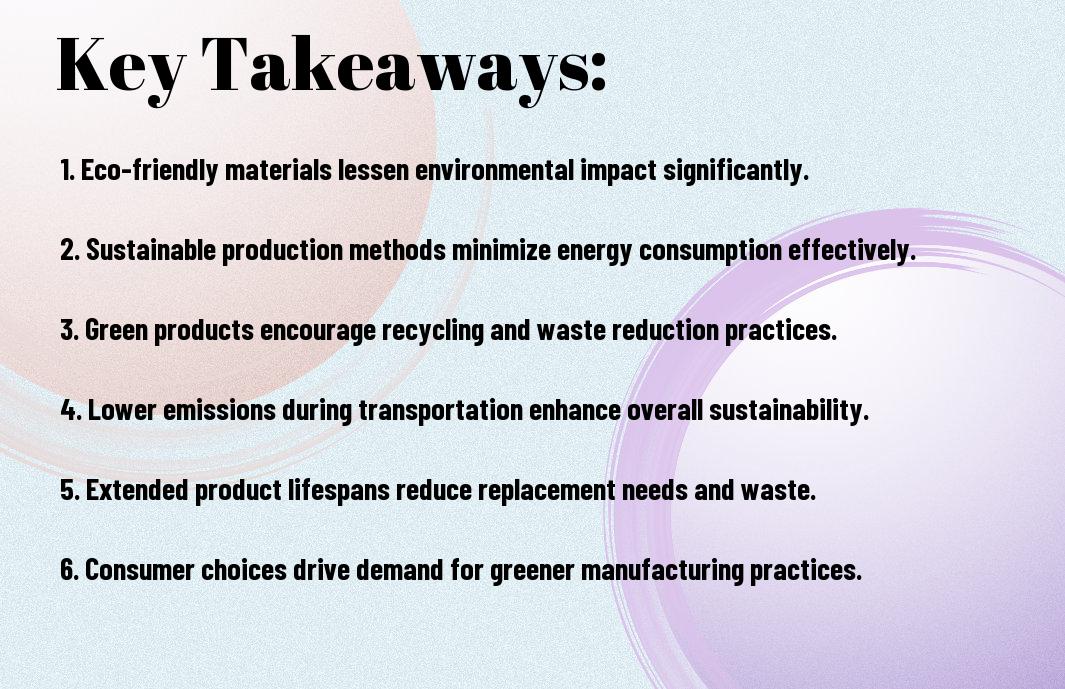As you make choices about the products you use in your daily life, you have the power to significantly impact the environment. Your decisions can contribute to a reduction in carbon emissions, helping to mitigate climate change. By opting for green products, you can decrease your carbon footprint and make a positive impact on the planet. You will learn how these products can help you achieve a more sustainable lifestyle and contribute to a healthier environment.
Key Takeaways:
To minimize our impact on the environment, it’s necessary to consider the benefits of green products. Here are a few key points to consider:
- Using renewable energy sources and sustainable materials in products helps to reduce carbon emissions and decrease our reliance on non-renewable resources.
- Eco-friendly products often have a lower carbon footprint due to their production process, which can involve recycling, biodegradable materials, and energy-efficient manufacturing.
- By choosing green products, individuals can contribute to a sustainable future by supporting companies that prioritize environmental conservation and responsible manufacturing practices.

Benefits of Green Products
For individuals and organizations seeking to minimize their environmental impact, green products offer a range of advantages. You can reduce your carbon footprint and contribute to a more sustainable future by choosing eco-friendly options.
Reduced Emissions
Prior to making the switch to green products, you likely generated more emissions than necessary. You can significantly decrease your emissions by opting for products with minimal packaging and those that are designed to be energy-efficient.
Sustainable Resources
Generally, green products are made from sustainable resources that can be replenished naturally. You can trust that your choice of green products supports the conservation of natural resources for future generations.
In fact, when you choose products made from sustainable resources, you are promoting environmentally responsible practices throughout the supply chain, from sourcing to production, and ultimately, to disposal, which helps to minimize waste and your overall environmental impact.
Types of Green Products
Even as you consider reducing your carbon footprint, various options are available. You can choose from:
- Solar panels
- Energy-efficient light bulbs
- Eco-friendly cleaning supplies
- Recycled products
- Renewable energy systems
Recognizing your choices, the following table summarizes some green products:
| Product | Description |
|---|---|
| Solar panels | Convert sunlight to electricity |
| Energy-efficient light bulbs | Low energy consumption |
| Eco-friendly cleaning supplies | Nontoxic and biodegradable |
| Recycled products | Made from recycled materials |
| Renewable energy systems | Generate energy from natural sources |
Eco-Friendly Cleaning Supplies
Around the house, you can opt for eco-friendly cleaning supplies that are better for your health and the environment, reducing your carbon footprint with every use.
Energy-Efficient Appliances
Beneath the surface of your daily routine, energy-efficient appliances can make a significant impact on your carbon footprint, allowing you to save energy and money.
Consequently, when you switch to energy-efficient appliances, you will notice a decrease in your energy consumption, leading to a lower carbon footprint and a more sustainable lifestyle, enabling you to contribute to a healthier planet for yourself and future generations.

Impact on Carbon Footprints
Once again, you will notice a significant difference in your carbon footprint when you switch to green products, as they are designed to minimize environmental impact, reducing the amount of waste and pollution you generate.
Decreased Greenhouse Gases
Behind the scenes, green products play a significant role in decreasing greenhouse gas emissions, which contribute to climate change, and by choosing these products, you are doing your part to reduce your environmental impact.
Conservation of Natural Resources
Before making a purchase, consider the environmental impact of the product, and you will find that green products help conserve natural resources, such as water and energy, which are vital for your well-being and the planet’s sustainability.
With the conservation of natural resources in mind, you can make informed choices about the products you use, and by opting for green products, you will be helping to preserve the planet’s precious resources for future generations, ensuring a healthier and more sustainable environment for you and your community to thrive in.
Making the Switch to Green
Your daily choices have a significant impact on the environment, and opting for green products is a great way to reduce your carbon footprint. By choosing eco-friendly alternatives, you can contribute to a more sustainable future.
Simple Changes at Home
With just a few tweaks to your daily routine, you can make a significant difference. Start by replacing traditional light bulbs with energy-efficient ones and using eco-friendly cleaning products to minimize your environmental impact.
Supporting Eco-Friendly Companies
Averse to contributing to environmental degradation, you can vote with your wallet by supporting companies that prioritize sustainability. Look for products with minimal packaging and made from recycled materials.
Switch to companies that adhere to environmentally responsible practices, and encourage others to do the same. As you continue to support eco-friendly businesses, you’ll be promoting a culture of sustainability and driving demand for green products, ultimately helping to reduce carbon footprints and create a healthier planet for you and future generations.
Green Technology and Innovation
All around the world, you are seeing a shift towards environmentally friendly technologies that reduce your carbon footprint. You can implement these innovations in your daily life to make a positive impact on the planet.
Renewable Energy Sources
Replenishing energy sources like solar and wind power are becoming increasingly popular, allowing you to generate clean energy and reduce your reliance on fossil fuels, which in turn reduces your carbon footprint.
Sustainable Manufacturing Practices
Behind the scenes of your favorite green products, you will often find eco-friendly manufacturing processes that minimize waste and pollution, enabling you to make more sustainable choices as a consumer.
Practices such as using recycled materials, reducing water consumption, and implementing energy-efficient systems are just a few ways you can make your manufacturing processes more sustainable, and as a consumer, you can support companies that prioritize these practices, further reducing your carbon footprint.
Community Involvement
After adopting green products, you can extend your impact by engaging with your community, promoting sustainable practices and encouraging others to reduce their carbon footprints, thereby creating a collective positive effect on the environment.
Local Environmental Initiatives
Beside the benefits of individual actions, participating in local initiatives allows you to contribute to a larger movement, supporting your community’s efforts to protect the environment and foster a sense of shared responsibility for a sustainable future.
Global Cooperation for a Sustainable Future
On a global scale, your support for green products contributes to a broader movement, as international cooperation and agreements drive the development of sustainable technologies and practices, ultimately benefiting your community and the world at large.
Another aspect of global cooperation is the exchange of innovative ideas and solutions, enabling you to learn from and collaborate with people worldwide, leveraging the power of collective action to address the complex challenges of climate change and environmental degradation, and creating a better future for yourself and generations to come.
Final Words
From above, you’ve learned how green products significantly reduce your carbon footprint. By choosing these eco-friendly alternatives, you minimize your impact on the environment. Your conscious decisions help decrease pollution, conserve resources, and promote sustainability. As you continue to make informed choices, you’ll contribute to a healthier planet, ensuring a better future for yourself and future generations.
FAQ
Q: What are green products and how do they contribute to reducing carbon footprints?
A: Green products are items that are environmentally friendly and sustainable, made from materials that have a lower impact on the environment. They contribute to reducing carbon footprints by minimizing waste, using renewable resources, and decreasing the amount of greenhouse gas emissions during production and use. For example, energy-efficient light bulbs, recycled paper products, and solar panels are all types of green products that help reduce carbon footprints.
Q: How do green products reduce greenhouse gas emissions?
A: Green products reduce greenhouse gas emissions in several ways. They are designed to be more energy-efficient, which means they use less power to operate. Additionally, many green products are made from sustainable materials that require less energy to produce, and some are even made from recycled materials. This reduction in energy consumption leads to lower greenhouse gas emissions, which contribute to global warming and climate change. By choosing green products, individuals can significantly decrease their carbon footprint and help mitigate the effects of climate change.
Q: What role do renewable energy green products play in reducing carbon footprints?
A: Renewable energy green products, such as solar panels and wind turbines, play a significant role in reducing carbon footprints. These products generate energy from renewable sources, such as sunlight and wind, which are sustainable and do not emit greenhouse gases. By using renewable energy green products, individuals and businesses can reduce their reliance on fossil fuels, which are a major contributor to carbon emissions. This shift towards renewable energy can significantly decrease carbon footprints and help create a more sustainable future.
Q: How can individuals incorporate green products into their daily lives to reduce their carbon footprints?
A: Individuals can incorporate green products into their daily lives in many ways. They can start by making simple changes, such as switching to energy-efficient light bulbs, using public transport or biking, and buying products made from sustainable materials. They can also invest in green technologies, such as solar panels or energy-efficient appliances, to reduce their energy consumption. Additionally, individuals can make a conscious effort to reduce waste by choosing products with minimal packaging, buying in bulk, and recycling. By making these changes, individuals can significantly reduce their carbon footprints and contribute to a more sustainable future.
Q: What are the long-term benefits of using green products to reduce carbon footprints?
A: The long-term benefits of using green products to reduce carbon footprints are numerous. By reducing greenhouse gas emissions, green products can help mitigate the effects of climate change, such as rising sea levels and extreme weather events. Additionally, green products can help conserve natural resources, reduce waste, and promote sustainable development. In the long term, the widespread adoption of green products can lead to significant economic benefits, such as job creation and cost savings, as well as improved public health and well-being. By choosing green products, individuals and businesses can contribute to a more sustainable future and ensure a healthier planet for generations to come.